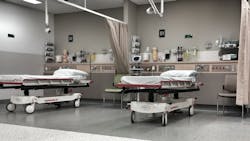Study reveals hospitals can exceed FDA guidelines for cleaning and disinfecting beds, mattresses
A new peer-reviewed study published in Sage Journals’ Infectious Disease Research and Treatment publication, found that cleaning and disinfecting mattresses by using removable, launderable bed barriers is more effective at eliminating bacteria that cause C. diff, MRSA, and E.coli than manual processes using chemical disinfectants.
These findings indicate a new, much-needed industry best practice that hospitals must adopt to keep patients safe – especially in today’s COVID-19 reality as more patients begin to re-enter hospitals and resume elective procedures. Most hospitals currently conduct a manual one-step process of cleaning hospital beds and mattresses, despite being off-label use of the disinfectant and the manufacturer’s multi-step instructions for cleaning and disinfection.
Studies have also shown that mattresses, which are difficult to disinfect, contribute to the high rates of hospital-acquired infections (HAIs) in the United States. These concerns prompted ECRI to cite mattress contamination as one of its top health hazards in both 2018 and 2019.
“We evaluated the effectiveness of the commercial laundry process under extreme test conditions, using high concentrations of soilage, blood, and urine. Laundering the removable bed barriers eliminated every major organism that contributes to HAIs—when the fabric was tested both at the beginning and end of life of the barrier,” said Edmond Hooker, MD, DrPH, an epidemiologist and practicing physician who co-authored the study, “The findings are both significant and timely as hospitals grapple with growing concerns about patient safety and how to prevent the spread of COVID-19 and other diseases. The time is now to take action and protect patients with this evidenced-based approach to cleaning and disinfecting.”
The commercial laundry process detailed in the study provides detergent, bleach, agitation, and repeatability. These elements allow bacteria and spores to be physically separated from the barrier surface. The chlorine works to kill residual organisms. Multiple rinse cycles allow the microorganisms to be removed from the washing machine.
“The current state of cleaning and disinfecting beds and mattresses is dangerous because it can leave residual bacteria that can be transmitted from patient to patient. However, laundering removable bed barriers provides an alternative. It eliminates issues with insufficient removal of pathogens from the patient surface,” said Ardis Hoven, MD, Professor of Medicine at the University of Kentucky and an Infectious Disease consultant to the Kentucky Department for Public Health.
“Unlike the commonly used manual process, it exceeded FDA guidance on this type of device. Hospital administrators must translate this new knowledge into action to protect the patients and families they serve.”
Trinity Guardion, the maker of the Soteria Bed Barrier, sponsored the study. Dr. Hooker is a professor at Xavier University’s Department of Healthcare Administration and associate professor at the University of Cincinnati Medical Center.
